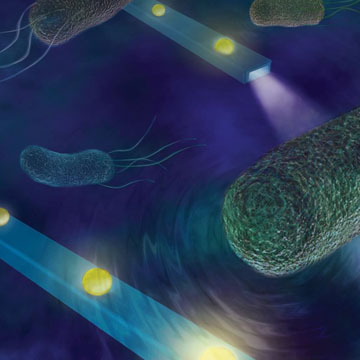
Artist’s conception of nano-optical fibers detecting femtonewton-scale forces produced by swimming bacteria. [Image: Rhett S. Miller/University of California Regents]
Conventional optical fibers make great sensors in the macroscopic world, but they're much too big to detect forces created by swimming bacteria. Now, researchers at a U.S. university have fabricated nanoscale fibers that can feel moving microorganisms and hear the sounds of living cells (Nature Photon., doi:10.1038/nphoton.2017.74).
Nanofiber optic force transducers
The University of California, San Diego (UCSD) researchers built “nanofiber optic force transducers” out of tin dioxide on a silica or quartz substrate. Each of these tiny waveguides had a cross-section of 200 to 400 nm and a polyethylene-glycol cladding less than 20-nm thick.
According to UCSD engineering professor Donald J. Sirbuly, the study’s lead author, one of the biggest challenges the team faced was in synthesizing the claddings to be evenly sized and reproducibly compressible. Fortunately, polyethylene glycol's mechanical properties are well known, and after grafting the polymer onto the nanofiber surface, the researchers thoroughly studied the indentation and restoration of the cladding.
The team calibrated the transducers by placing gold nanoparticles on top of the waveguide, then launched a beam of 325-nm laser light through the device. An atomic force microscope (AFM) measured the interaction of the light energy with the particles. In doing this, however, the researchers had to add a nanoparticle to the microscope's probe tip to avoid dislodging the experimental particles from the device. Sirbuly says the combined optical/AFM system simultaneously placed controlled forces on the particles and tracked their optical scattering with angstrom-level resolution.
Bacterial motion and heart-cell beating
Next, the group placed the nanofibers in a solution of Helicobacter pylori— the first microbe found to be living in the acidic environment of the human stomach. As the bacteria swam by the nanoscale sensor, their motions deflected the nanoparticle-waveguide cantilever. The researchers measured the forces exerted by the swimming microorganisms down to 160 femtonewtons (1.6×10–13 N).
Finally, to test the sound sensitivity of the tiny transducer, the researchers placed the device about 100 μm from a culture of live mouse-heart cells. The system detected the sounds of the cells “beating” at 1 to 3 Hz with an acoustic sensitivity of –30 dB.
In the future, Sirbuly says, the team will work on new uses for the nanofibers, such as single-cell mechanical studies and bio-activity tracking. Furthermore, he shares that, “In addition we will be optimizing the acoustic response of the nanofibers for stethoscopic applications, and investigating new imaging modalities using the optical and mechanical capabilities of the technology.”
